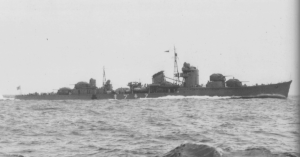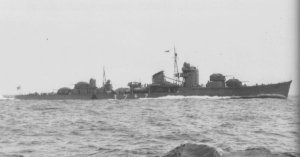
U.S Navy To Expand Influence In South China Sea By Funding Philippines Fast Boat Base
July 19, 2025
Port Of Barcelona To Reduce Cruise Ship Terminals To Curb Overtourism
July 19, 2025

The Imperial Japanese Navy’s flagship destroyer Teruzuki, a World War II shipwreck, has been discovered in Iron Bottom Sound. The ship was located on July 12, 2025, by a team aboard the Exploration Vessel Nautilus using advanced seafloor mapping tools and remotely operated vehicles (ROVs).
The wreck was found more than 800 meters below sea level. The target was first detected by the University of New Hampshire’s uncrewed surface vessel (USV) DriX. Later, the Nautilus team launched ROVs that visually confirmed the ship’s identity.
Teruzuki, which means “Shining Moon” or “Illuminated Moon,” was a 134-meter-long Akizuki-class destroyer commissioned in 1942. It was designed to defend Japanese aircraft carriers from air attacks.
The ship played an important role in the Guadalcanal campaign and served as the flagship for Rear Admiral Raizō Tanaka, a skilled Japanese naval tactician known for leading night operations and resupply missions.
On December 12, 1942, Teruzuki was attacked near Cape Esperance. It was hit by two American Mk-8 torpedoes that damaged its rudder and caused a fire. Although Admiral Tanaka and most of the crew survived the attack, nine sailors were killed before the destroyer sank.
During the recent exploration, researchers discovered a 19-meter-long section of Teruzuki’s stern that had broken off from the main ship. This stern, scattered with depth charges, was found over 200 meters away from the main hull. Based on this finding, the team confirmed that the ship’s stern was blown away by the torpedo strike and not by an explosion from the depth charges, which was a theory held for years.
The ship’s forward gun turrets were found still pointing upwards. Experts used historical references and high-resolution sonar scans to identify the wreck and confirm it as Teruzuki.
A Japanese researcher from Kyoto University, who was part of the exploration team, shared that it was a special moment to witness a lost part of Japanese history and contribute to a project that connects the histories of multiple nations.
This discovery is part of a larger mission supported by NOAA Ocean Exploration under the Ocean Exploration Cooperative Institute. The team has already documented 12 World War II shipwrecks, with many more believed to lie undisturbed in Iron Bottom Sound, a key battlefield where five major naval battles occurred between August and December 1942.
The mission is led by Dr. Robert Ballard, President of Ocean Exploration Trust. It includes a broad international group of collaborators from the U.S., Japan, Australia, New Zealand, and the Solomon Islands. Partners include the U.S. Naval History and Heritage Command (NHHC), NOAA Ocean Exploration, the University of New Hampshire, and the University of Rhode Island.
People around the world can follow the exploration in real time through live video and educational programs at www.NautilusLive.org. Experts are using telepresence technology to provide live commentary and historical context during the mission.
Earlier in February 2025, a separate mission led by Woods Hole Oceanographic Institution (WHOI) and the Naval History and Heritage Command (NHHC), aboard the research vessel Atlantis, used the human-occupied vehicle Alvin to explore the wrecks of two U.S. Navy ships off San Diego.
Reference: Naval History and Heritage Command
Source: Maritime Shipping News


